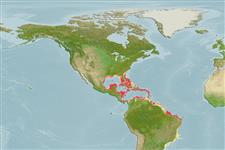Environment: milieu / climate zone / depth range / distribution range
Ecologie
marien rifbewoner; diepte 10 - 40 m (Ref. 5222). Subtropical; 33°N - 29°S, 98°W - 33°W (Ref. 5222)
Western Atlantic: southern Florida (USA) and the Gulf of Mexico to Brazil. It was suggested that Mycteroperca tigris was a transient species in the northwestern Gulf of Mexico, but has recently become abundant on the Flower Garden Banks off Texas (Ref. 6887).
Lengte bij maturiteit / Grootte / Gewicht / Leeftijd
Maturity: Lm 46.0, range 34 - ? cm
Max length : 101 cm TL mannelijk / geslacht onbekend; (Ref. 26340); common length : 40.0 cm TL mannelijk / geslacht onbekend; (Ref. 5217); max. gepubliceerd gewicht: 10.0 kg (Ref. 5222)
Dorsale stekels (totaal) : 11; Dorsale zachte stralen (totaal) : 15 - 17; Anale stekels: 3; Anale zachte stralen: 11. Distinguished by the following characteristics: Back crossed by about 11 pale narrow lines that slope downward and forward. No other grouper in the Caribbean has the same pattern of narrow pale diagonal lines (Ref. 26938). Further characterized by having depth of body contained 3.1-3.6 times in SL; head length 2.5-2.8 times in SL; flat interorbital area; rounded preopercle, without lobe at angle; diameter of posterior nostrils 3-5 times larger than anterior ones; large teeth, well developed canines (Ref. 89707).
A solitary species (Ref. 26340) occurring in coral reefs and rocky areas. It is considered an ambush predator that hides among the coral and sponges and is easy to approach. Frequents cleaning stations (Ref. 9710). The size versus sex distribution of Bermuda population indicates that this species is a protogynous hermaphrodite; all fish less than 37 cm TL were females and all fish larger than 45 cm TL were males (Ref. 6886). Randall (Ref. 33) reported food of 59 specimens 15 to 57 cm SL were purely fishes of a variety of species.
Levenscyclus en paargedrag
Maturiteit | Voortplanting | Paaien | Eieren | Fecunditeit | Larven
Heemstra, P.C. and J.E. Randall, 1993. FAO Species Catalogue. Vol. 16. Groupers of the world (family Serranidae, subfamily Epinephelinae). An annotated and illustrated catalogue of the grouper, rockcod, hind, coral grouper and lyretail species known to date. Rome: FAO. FAO Fish. Synop. 125(16):382 p. (Ref. 5222)
Status op de Rode Lijst van het IUCN (Ref. 130435: Version 2024-2)
Gevaar voor de mens
Reports of ciguatera poisoning (Ref. 30911)
Gebruik door de mens
Visserij: commercieel; sportvis: ja; Aquarium: Publieke aquaria
Tools
Speciale rapporten
Download XML
Internetbronnen
Estimates based on models
Preferred temperature (Ref.
123201): 24.7 - 28, mean 27 °C (based on 148 cells).
Fylogenetische diversiteitsindex (Ref.
82804): PD
50 = 0.5000 [Uniqueness, from 0.5 = low to 2.0 = high].
Bayesian length-weight: a=0.01122 (0.00647 - 0.01946), b=3.06 (2.91 - 3.21), in cm total length, based on LWR estimates for this species & Genus-body shape (Ref.
93245).
Trofisch niveau (Ref.
69278): 4.5 ±0.8 se; based on diet studies.
Generation time: 10.0 ( na - na) years. Estimated as median ln(3)/K based on 1
growth studies.
Weerstandsvermogen (Ref.
120179): laag, minimale populatieverdubbelingstijd 4,5-14 jaar (K=0.11; tm=6.5-9.5).
Fishing Vulnerability (Ref.
59153): High vulnerability (64 of 100).
Nutrients (Ref.
124155): Calcium = 13.3 [7.5, 27.5] mg/100g; Iron = 0.455 [0.229, 0.802] mg/100g; Protein = 19.4 [17.6, 21.1] %; Omega3 = 0.192 [0.110, 0.338] g/100g; Selenium = 16.8 [7.6, 35.7] μg/100g; VitaminA = 71.6 [22.0, 263.4] μg/100g; Zinc = 0.511 [0.329, 0.788] mg/100g (wet weight);
